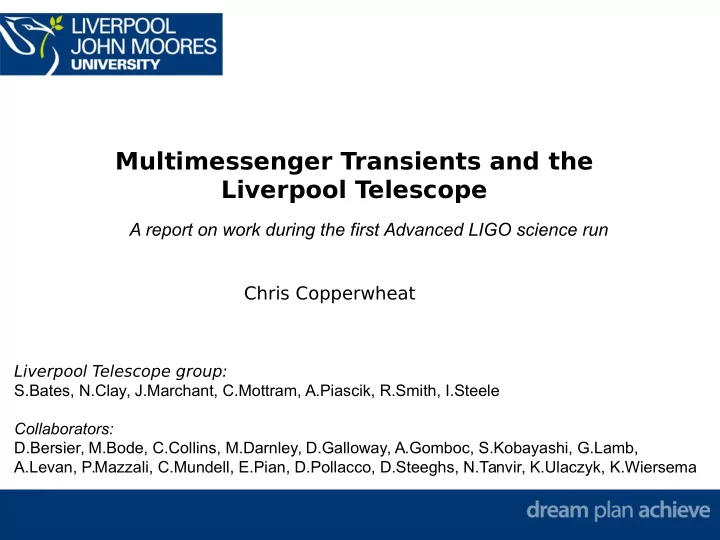

Multimessenger Transients and the Liverpool Telescope A report on work during the first Advanced LIGO science run Chris Copperwheat Liverpool Telescope group: S.Bates, N.Clay, J.Marchant, C.Mottram, A.Piascik, R.Smith, I.Steele Collaborators: D.Bersier, M.Bode, C.Collins, M.Darnley, D.Galloway, A.Gomboc, S.Kobayashi, G.Lamb, A.Levan, P.Mazzali, C.Mundell, E.Pian, D.Pollacco, D.Steeghs, N.Tanvir, K.Ulaczyk, K.Wiersema
In the multi-messenger era, electromagnetic counterparts are (a) poorly localised and (b) faint So what is the role for 'small' optical/IR telescopes with ~arcmin fields-of-view? (Commissioning and Observing Scenarios for the aLIGO and (Adapted from Metzger and Berger, 2012) AdvVirgo GW Observatories, 2012)
The 'follow-up gap' Transient science has been revolutionised by the big synoptic surveys (iPTF, Pan-STARRS, MASTER, ASAS-SN...) But our survey capacity has massively outpaced our capacity for follow-up Only ~10 per cent of transients get a (Adapted from LSST science book) spectroscopic classification (An increasingly urgent problem as we approach the LSST era) Multi-messenger example: GW151226 campaign – 77 candidates reported to EM follow-up collaboration via GCN – Firm classification for 37 candidates – just under 50 per cent – A number of the rest faded by the time follow-up was attempted 3
4 The Liverpool Telescope is a 2-metre fully robotic telescope located at the ORM on La Palma 4 4
IO IO:I (near-IR) • 2048 x 2048 Hawaii-2RG array (1.7 µ m cutoff) • H-band fixed filter (i.e. no filter wheel – would require new cryostat) • Pixel scale: 0.18 arcsec • FOV: 6 x 6 arcmin IO:O (optical) • Our work-horse imager • 4096 x 4112 pixel e2v CCD • Filters: u'g'r'i'z' + BV + 5 H α ’s • Pixel scale: 0.15 arcsec • FOV: 10 x10 arcmin 5
SPRAT ● Long-slit optical spectrometer ● Slit and grism deployable ● R ~ 350; λ range 400-800 nm ● Slit width: 1.8 arcsec ● Pixel scale: 0.44 arcsec ● Acquis. FOV: 7.5 x 1.9 arcmin Right : calibrated SPRAT spectrum of ASASSN-15ho observed within 12 hours of ATEL announcement on 21-04-15. Object classified as a type Ia at 4 days post maximum. Data courtesy: A. Piascik (LJMU) V ~ 16.9 mag; 600 sec exposure 6
Other LT Instruments RINGO3 (Three arm fast polarimeter) RISE (Fast photometer) LOTUS (UV spectrograph) FRODOspec (IFU intermediate resolution spectrograph) 7
Wide-field imaging: Skycams 9 o field, 90% complete down to R ~ 12th mag T Z 1 o field; sensitive down to ~18th mag A A T Z 8 8
GW150914 campaign 25 different teams particpated in the follow-up of this event. 29 candidates classified (iPTF: Kasliwal et al. 2016, Pan-STARRS: Smartt et al. 2016) 9 Abbott et al. 2016
GW150914: LT contribution La Palma not well placed for follow-up of this event Spectrum of one candidate obtained in twilight 10
GW151226 campaign iPTF fields overlaid on LIGO skymap 11
GW151226: LT contribution 17 candidates observed over ~1 week following LIGO trigger Mostly supernovae – classification from SNID (Blondin & Tonry 2007) Some non-detections: transient faded below background galaxy level 12
13
Conclusions from first aLIGO campaign ● Transient classification is at least as serious a problem as transient identification in the multi-messenger era. ● Lack of low/intermediate resolution spectroscopic follow-up capacity ● Main contaminant based on this initial work seems to be supernovae – modern surveys efficient at eliminating other types of transient ● Many candidates have faded by the classification stage – rapid reporting of transients and rapid classification important ● With the right instrument, small telescopes can play a big role in this exciting science: 12 out of 37 classifications for GW151226 from 2-metre LT. 14
Current / near-future work Rapid reaction ● We have developed a new interface for the LT, allowing observing groups to be submitted via a command line tool ● Closing the follow-up loop: spectroscopic follow-up of machine readable transient alerts with no human intervention Expanding the classification network ● We are in the process of appointing a new LT instrument scientist (OPTICON funded) ● Develop a cheap, modular version of SPRAT for small telescopes across the continent 15
Large Robotic Telescope A new, 4-metre class robotic telescope for rapid follow-up ● of astrophysical transients. Largest robotic telescope in the world To be co-located with the LT on La Palma ● First light ~2022 to capitalise on ● new discovery facilities Versatile instrument payload ● spectroscopy a core focus (X-shooter type instrument) World-leading response ● time for fast fading / fast evolving transients, efficient programmes 16
A new role for the LT ● 2-metre LT to stay operation and support science on 4-metre LRT ● Current instrument suite to be replaced with single prime focus imager ● 2x2 deg field for targeted surveys for poorly localised transients 17
Large Robotic Telescope: Copperwheat et al., 2015, ExA, 39, 119 (arXiv:1410.1731) GW follow-up: Copperwheat et al., 2016, MNRAS, 462, 3528 (arXiv:1606.04574) c.m.copperwheat@ljmu.ac.uk 18
Recommend
More recommend